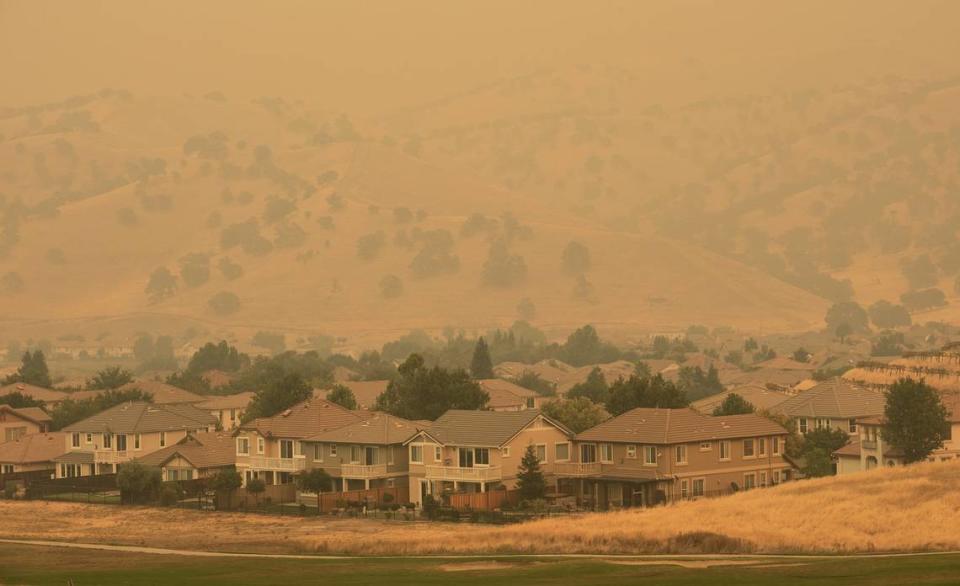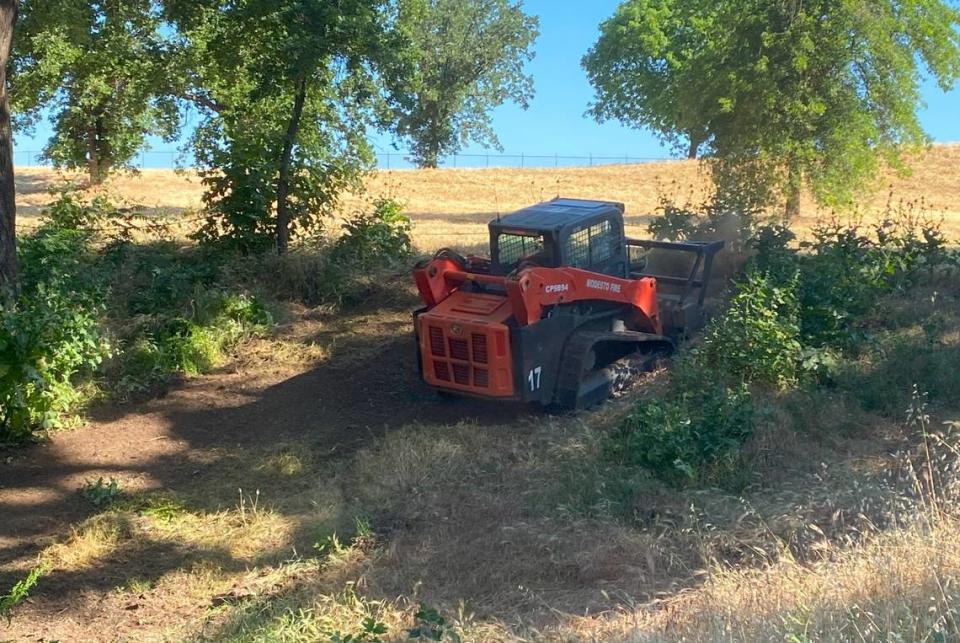How warming climate stokes massive wildfires, impacting health of Stanislaus area residents
This story is part of a Modesto Bee series on climate change impacts for Stanislaus County.
Massive wildfires are regarded as one of the destructive effects of climate change.
Smoke, coming from fires in other parts of California, often drifts into the San Joaquin Valley, affecting the health of people in Modesto and other communities.
Five of the six largest wildland fires in California’s recorded history burned at the same time in August and September 2020, including the SCU Lightning Complex fire that raged across 394,600 acres in the mountain range west of Patterson.
The San Joaquin Valley has an inversion layer that traps air pollution from vehicles, industries and farm operations, and wildfire smoke adds to the dirty mix for the 4.3 million residents of the Valley.
“When we have catastrophic wildfires, maybe in other parts of the state, the smoke comes to the San Joaquin Valley and can be quite a health impact for folks,” said Jaime Holt, a spokeswoman for the San Joaquin Valley Air Pollution Control District. “It’s not unheard of for the air quality to deteriorate to the (unhealthy) red zone and occasionally the purple zone, which is severely unhealthy.”
Wildfire smoke can exceed the Valley’s total emissions from industrial sources and motor vehicles. It increases the fine particles in the air pollution that are damaging to health, especially for seniors and young children and people with emphysema, asthma, heart disease and other chronic illness.

The particles are taken deep into the lungs, where the smallest can’t be filtered out and are absorbed in the bloodstream. That can worsen cardiac disease and possibly play a role in dementia.
Holt said even healthy people should limit exposure to the pollution and skip a daily run on smoky days.
State and local fire agencies contend with a longer fire season stretching into November and December, due to shorter seasons of rain and snow in the Sierra.
How climate change and wildfires are connected
Numerous studies have tied large and unpredictable wildfires to climate change, as warmer temperatures, drought, dry vegetation and widespread death of drought-stricken trees have served to fuel enormous wind-driven fires.
According to a UCLA study released in May, 18 of the 20 largest fires on record in California happened since 2003, with wildfires resulting in 302 deaths and destroying 60,000 structures during that period.
A climate change assessment for the Governor’s Office of Planning and Research predicts the areas burned by fires each year will be 12% larger by the middle of the century.
Because the trees and vegetation in forests act as a carbon sink, storing CO2 drawn from the atmosphere, reforestation is an important goal in the state’s climate plan.
Challenges for local fire agencies
The Modesto Fire Department and other local agencies may respond to assist with wildland fires and other emergencies anywhere in California and in other states including Nevada, Oregon and Washington.
Modesto Deputy Chief Darin Jesberg said an increased amount of dry vegetation in Stanislaus County can pose difficulties for emergency units. “Once a fire occurs in those areas, the fire behavior is very chaotic, sporadic and unpredictable,” he said.
Jesberg said the fire department doesn’t necessarily do more training for the bigger wildfires plaguing the state. “We train annually to refresh on various topics, tactics and strategies,” he said in an email. Every year, fire agencies are briefed on expected weather patterns for the region, the potential for flooding or drought and fire danger.
Years of drought were followed by excessive rainstorms this past winter, which produced more vegetation that is now drying in the triple-digit summer heat. In years with milder weather patterns, the amount of fuel and fire danger is not as much, Jesberg said.
The fire agency has an annual program to manage and mitigate dangerous fire-risk areas such as Tuolumne River Regional Park, Dry Creek Park and areas around Oakdale and Knights Ferry.
To prevent wildfires in the state, the California Wildfire and Forest Resilience Action Plan has recommendations to expand prescribed-fire forest maintenance to 100,000 acres within two years and extend the program to state land. According to the plan, the U.S. Forest Service is aiming for prescribed fire maintenance on up to 500,000 acres by 2025.
The state plan has goals to identify and evaluate wildland fire hazards and support local land planning to protect life, property and natural resources.
More fire prevention planning is expected for Mother Lode areas like Tuolumne and Calaveras counties, where 101,100 residents live with wildfire risk.

Free air purifiers for eligible households
The San Joaquin Valley Air Pollution Control District is not involved with fire prevention but its member counties and cities are supporting forest management, hoping it will keep wildfires from polluting the air.
Holt said until the surprising wet season last winter, drought was a huge concern along with the potential for wildfires “in a size we had not seen before.”
In a new program, the district is advising residents to dedicate a “clean air room,” such as a bedroom, when smoke inundates their community and creeps into homes. People would close doors and windows and run an air purifier in the room.
The district has been giving free portable air filtration units to residents in disadvantaged and low-income communities and still has plenty of purifiers available for eligible people in Stanislaus County. The devices certified by the California Air Resources Board can reduce particles floating in the room by 90%, the air district said.
The air district has no crystal ball for wildfire predictions as the planet warms, Holt said, but “we are going to be prepared. We work to make sure the public is aware smoke is a risk and give them tools to protect themselves against wildfire smoke.”
